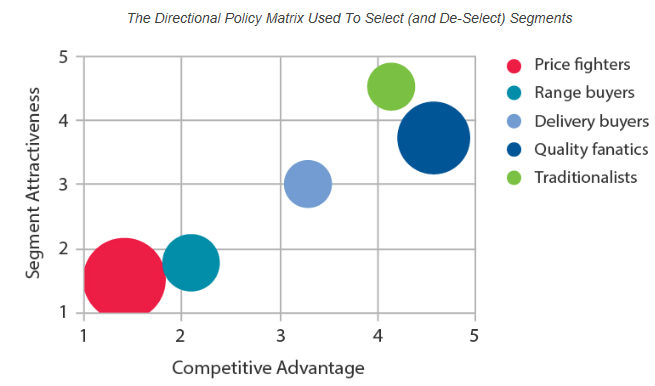No company has the resources to successfully satisfy every potential target market. Careful and considered customer segmentation is crucial to success. Around one half of all business-to-business companies make a serious attempt to segment their customers.

Segmentation
Each of us is unique. We love to be treated as individuals and rightly so. Nothing annoys us more than when our individuality is not recognized by a supplier. On the other side of the equation, companies find it extremely difficult to manage their resources if they were to give the same individual treatment to every customer. Segmentation is the process by which we recognize different groups of customers with important similarities so they can be addressed in a way that acknowledges their central needs. Segmentation is therefore at the heart of successful marketing strategies.
Customers can be grouped together in different ways. As private individuals we can be clustered demographically according to our gender, age, income, where we live, our attitudes and possibly even our psychographic profiles. Business customers can similarly be categorized, though not necessarily in the same way. Their demographic characteristics (we refer to them as firmographics) can be classified according to the size of the company, industry vertical, the number of years the company has been established, its geographical location, whether it is a private or public enterprise and so on. These firmographic considerations are critically important as they are easily recognized characteristics and they are very often a good indication of needs.
Behavior can also be a good indicator of needs. Customers that switch suppliers regularly, or use multiple suppliers, or buy at infrequent intervals, may all have needs reflected by these patterns of behavior. Above all, we are trying to identify segments of customers with different needs so we can tailor our products and services to better satisfy what they want. Furthermore, if we can group customers according to their needs, we can communicate with them in ways that will resonate and encourage them to buy more from us.
Researchers have a variety of questions that they use to segment customers and potential customers. Some of these questions are geared to segment customers at the time they are choosing a supplier in the first instance and other questions are used to show how they can be segmented in terms of their satisfaction and loyalty once they have become customers.
Segmentation doesn’t have to be based on market research. Some companies arrive at a segmentation based on a priori knowledge – that is classifying customers on in-house views as to customers’ needs. Often, segmentation strategies are based on a combination of market research and judgment.
Whatever route is used to arrive at the segmentation, the strategy should be assessed against the following criteria:
-
Each segment should be sizeable: segments should be big enough to matter and be worth addressing. Segments that are too small may be too expensive to address. It is sensible to keep the number of segments below five or six. Each segment requires its own marketing budget and marketing plan and this will be expensive.
-
Segments should be distinctive and recognizable: if it is hard to separate one segment from another, the likelihood is that the segmentation won’t work. Segments should be easily recognizable, either from firmographic information or a small number of “killer questions” which are asked of key decision makers at the customer to determine which bucket they go into.
-
Segments should be durable: segmentation strategies take a few years to have effect. It would be a flimsy segmentation strategy if customers constantly have to be reclassified between the segments.
-
Segments must be actionable: arguably the most important requirement of any segmentation is that it must be easy to use and implement. Most business-to-business segmentations have to be used by salespeople and they must be able to work with it and recognize its benefits.
Building segmentation into a marketing strategy will ensure that customers are not squeezed into a “one size fits all” approach which would be sure to miss the mark with many customers. A needs-based segmentation will get closer to satisfying requirements of most customers and will give a competitive edge.
Furthermore, a good segmentation strategy will show groups of customers where a company has a weak competitive advantage and so indicate that these are not important audiences to target. Segmentation allows a supplier to select and deselect groups of customers that are of interest and so leads to greater customer satisfaction and an improvement in profitability.

To learn more about this topic, please visit the following publications:
Market Segmentation in B2B MarketsA Practical Guide To Segmentation


